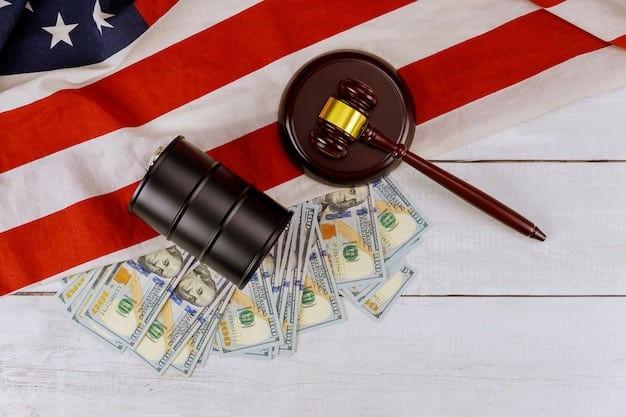Fed Rate Hike: Analyzing the 0.25% Increase & Financial Impact

A new Federal Reserve rate hike of 0.25% has been announced, impacting various aspects of personal finance including savings, borrowing, and investment strategies, as consumers and businesses navigate the changing economic landscape in the United States.
The Federal Reserve has recently announced another interest rate hike, increasing the rate by 0.25%. This decision is poised to ripple through the U.S. economy, impacting everything from the interest rates on your credit cards to the returns on your savings accounts. Let’s delve into the details of this new Federal Reserve rate hike announced: How will the 0.25% increase impact your finances?
Understanding the Federal Reserve’s Rate Hike
The Federal Reserve, often referred to as the Fed, plays a critical role in managing the U.S. economy. One of its primary tools is adjusting the federal funds rate, which is the target rate that commercial banks charge one another for the overnight lending of reserves. When the Fed raises this rate, it becomes more expensive for banks to borrow money, which in turn affects interest rates across the board.
What is the Federal Funds Rate?
The federal funds rate is a benchmark interest rate that influences many other interest rates in the economy. When the Fed increases this rate, banks typically pass on the higher cost of borrowing to their customers through higher interest rates on loans and credit cards. This can help to curb inflation by making it more expensive to borrow and spend money.
Why Did the Fed Raise Rates?
The Fed raises interest rates to combat inflation. Inflation occurs when the general price level of goods and services rises, reducing the purchasing power of money. By raising interest rates, the Fed aims to cool down the economy by making borrowing more expensive, which reduces spending and investment. This decrease in demand can help to bring inflation back to the Fed’s target level.
- Controlling Inflation: The primary goal is to reduce the pace of rising prices.
- Economic Stability: Higher rates can prevent the economy from overheating.
- Market Expectations: The Fed also considers market expectations and economic indicators when making decisions.
In summary, the Federal Reserve’s decision to raise rates is a strategic move to maintain economic stability and control inflation. By understanding the mechanics behind these rate adjustments, individuals can better prepare for the changes in their financial landscape.

Impact on Savings Accounts and CDs
One of the first places consumers might notice the impact of a Fed rate hike is in their savings accounts and certificates of deposit (CDs). As interest rates rise, banks often increase the interest rates they offer on these savings products.
Savings Accounts
With a rate hike, the interest rates on savings accounts tend to increase. This means you can earn more on your savings, albeit modestly. It’s important to shop around for the best rates, as not all banks will increase their rates by the same amount.
Certificates of Deposit (CDs)
CDs typically offer higher interest rates than regular savings accounts because you agree to keep your money deposited for a specific period. With a rate hike, the yields on new CDs will likely rise, making them a more attractive option for savers looking to lock in a higher rate.
- Higher Yields: Expect better returns on new savings accounts and CDs.
- Shop Around: Compare rates from different banks to find the best offers.
- Consider CD Terms: Choose CD terms that align with your financial goals and needs.
Overall, a Federal Reserve rate hike can be a positive development for savers, as it offers the potential to earn more interest on their deposits. By staying informed and comparing options, consumers can maximize the benefits of these rate increases.
Effects on Mortgages and Home Buying
Mortgage rates are closely tied to the Federal Reserve’s actions. When the Fed raises interest rates, mortgage rates typically follow suit, making it more expensive to buy a home. This can have a significant impact on both potential homebuyers and current homeowners looking to refinance.
Rising Mortgage Rates
The most direct impact of a Fed rate hike on the housing market is the increase in mortgage rates. Higher rates mean higher monthly payments for borrowers, which can reduce affordability and potentially cool down the housing market.
Impact on Homebuyers
For potential homebuyers, rising mortgage rates can be a deterrent. As borrowing becomes more expensive, some buyers may delay their home search or look for less expensive properties. This can lead to a decrease in demand and potentially slower price growth.
Rising mortgage rates affect those seeking to refinance, potentially diminishing savings from lower rates. Evaluate current vs. new rates and closing costs to determine benefits, adjusting financial strategies as needed.
- Reduced Affordability: Higher rates mean higher monthly mortgage payments.
- Slower Home Sales: Rising rates can lead to a decrease in demand.
- Refinancing Considerations: Evaluate if refinancing still makes sense with higher rates.
In conclusion, a Federal Reserve rate hike can have significant implications for the housing market, impacting both homebuyers and homeowners. Keeping an eye on mortgage rate trends and understanding the broader economic context is crucial for making informed decisions about buying or refinancing a home.
Credit Card Interest Rates
Credit card interest rates are another area where consumers will likely feel the effects of a Fed rate hike. Most credit cards have variable interest rates, which are directly linked to benchmark rates like the prime rate, which tends to move in tandem with the federal funds rate.
Variable Interest Rates
Most credit cards come with variable interest rates, meaning the rates can fluctuate based on market conditions. When the Fed raises rates, these variable interest rates on credit cards typically increase, making it more expensive to carry a balance.
Increased Borrowing Costs
With higher credit card interest rates, the cost of borrowing money on your credit card goes up. This means you’ll pay more in interest charges if you carry a balance from month to month. It’s a good time to review your spending habits and consider strategies to pay off your balances faster.
To mitigate the impact, prioritize paying off balances, consider balance transfers, and review spending habits. Reduce reliance on credit cards and explore lower-interest debt consolidation options to manage costs effectively.
- Higher APRs: Expect to see higher annual percentage rates on your credit cards.
- Increased Interest Charges: Carrying a balance will become more expensive.
- Debt Management: Focus on strategies to pay down your credit card debt.
In summary, a Federal Reserve rate hike can lead to higher credit card interest rates, making it more important than ever to manage your credit card debt wisely. By taking proactive steps to pay down balances and control spending, you can minimize the impact of these rate increases on your finances.
Impact on Business Loans
The Federal Reserve’s rate hike also affects businesses, particularly when it comes to loans and investment. Increased interest rates often translate to higher borrowing costs for businesses, which can influence their decisions regarding expansion, investment, and hiring.
Increased Borrowing Costs for Businesses
When the Fed raises rates, businesses typically face higher interest rates on loans. This can make it more expensive for them to finance investments in new equipment, facilities, or other growth initiatives. Consequently, some companies may scale back their investment plans.
Effects on Investment and Hiring
Higher borrowing costs can have a ripple effect on a company’s investment and hiring decisions. If it becomes more expensive to borrow money, a business might postpone or cancel expansion projects, which can lead to slower job growth. Companies seek alternative funding or streamline operations.

To navigate these challenges, businesses should explore alternative funding, optimize operations, and manage expenses. Review financial strategies to adapt to increased borrowing costs, ensuring sustainable growth.
- Higher Loan Rates: Businesses will face increased costs for borrowing.
- Slower Investment: Some companies may postpone expansion plans.
- Job Market Impact: Slower investment can lead to slower job growth.
In conclusion, a Federal Reserve rate hike can significantly impact businesses by increasing borrowing costs and potentially slowing down investment and job creation. Businesses need to adapt their financial strategies to navigate these challenges effectively and ensure sustainable growth.
Navigating the New Rate Environment
Adapting to a new interest rate environment requires proactive financial planning and strategic adjustments. Whether you are a consumer or a business owner, understanding the implications of a Fed rate hike and taking appropriate action can help you mitigate potential risks and capitalize on new opportunities.
Personal Finance Strategies
For individuals, the key to navigating a rising interest rate environment is to focus on managing debt and maximizing savings. This means paying down high-interest debt, shopping around for the best savings rates, and adjusting your budget to account for higher borrowing costs.
Business Adaptation
Businesses need to review their financial strategies to adapt to higher borrowing costs. This might involve exploring alternative funding sources, optimizing operations to reduce expenses, and carefully evaluating investment decisions to ensure they align with the new economic reality.
Consumers mitigate impacts by reducing debt, boosting savings, and adjusting budgets. Regularly review finances and seek professional advice. Businesses also optimize operations, funding, and investments for resilience.
- Debt Management: Focus on paying down high-interest debt.
- Savings Optimization: Shop for the best rates on savings accounts and CDs.
- Budget Adjustments: Adapt your budget to account for higher borrowing costs.
In summary, navigating a new interest rate environment requires a proactive and strategic approach to financial planning. By managing debt, maximizing savings, and adapting your budget or business strategy, you can successfully weather the changes and position yourself for long-term financial stability.
| Key Point | Brief Description |
|---|---|
| 💰 Savings Impact | Higher interest rates on savings accounts and CDs. |
| 🏡 Mortgage Rates | Increased mortgage rates, affecting home buying and refinancing. |
| 💳 Credit Cards | Variable interest rates on credit cards increase. |
| 🏢 Business Loans | Higher borrowing costs impact business investments. |
Frequently Asked Questions (FAQ)
▼
The Federal Reserve raised interest rates to combat inflation and maintain economic stability in the United States. By increasing borrowing costs, the Fed aims to cool economic activity and bring inflation back to its target level.
▼
Savings accounts typically see increased interest rates after a Fed rate hike. Although the increase may be gradual and modest, it offers a chance to earn slightly more on your savings. Shop around for the best rates!
▼
Mortgage rates typically rise following a Fed rate hike, making it more expensive to buy a home or refinance an existing mortgage. This can impact affordability and potentially slow down the housing market.
▼
Yes, credit card interest rates, especially those with variable APRs, will likely increase following a Fed rate hike. Higher rates increase the cost of carrying a balance, making it crucial to manage credit card debt effectively.
▼
Businesses face higher borrowing costs, which can influence their decisions on investments, expansions, and hiring. Some businesses may need to seek alternative funding options or optimize their operations.
Conclusion
In conclusion, the decision by the Federal Reserve to raise interest rates by 0.25% has wide-ranging implications for both consumers and businesses. Understanding how these changes affect your personal finances and business operations is essential for making informed decisions and navigating the evolving economic landscape.





